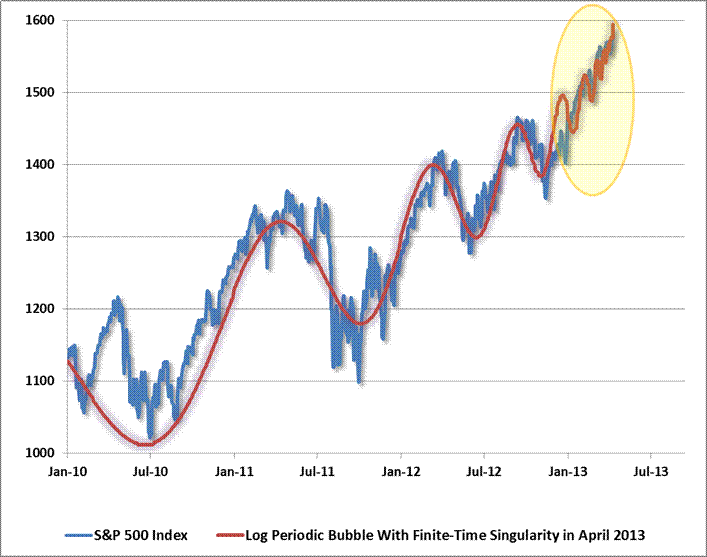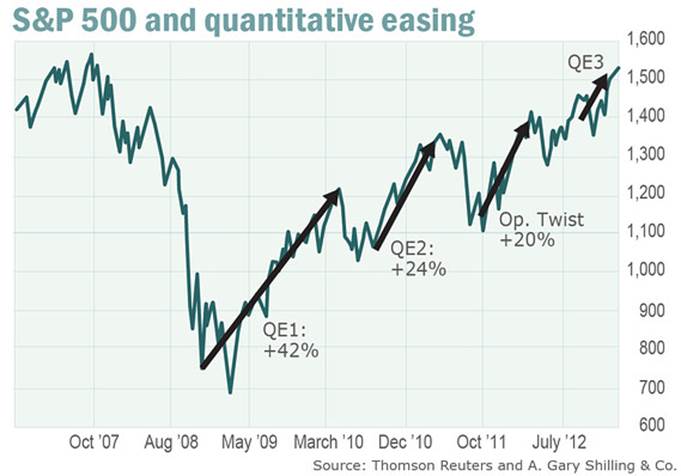Mark Twain wrote “Let me make the superstitions of a nation, and I care not who makes its laws.” In recent years, investors have somehow allowed themselves to be convinced that alchemy – exchanging outstanding government debt for zero-interest monetary liabilities despite what are already trillions in excess monetary liabilities – is capable having real, stimulative, and beneficial effects for the economy. Make no mistake – the faith that quantitative easing will produce anything other than temporary and ultimately calamitous financial distortion is superstition. Keep in mind that each dollar of monetary base must remain a dollar of monetary base until it is retired. It cannot “turn into” something else. The only two forms of monetary base are currency and bank reserves, and of the trillions of dollars of monetary base created since 2008, only $300 billion has taken the form of additional currency. All of the other trillions of dollars of base money that the Fed has created take the form of bits and bytes on some computer at one bank or another in the U.S. financial system. At every moment in time, someone in the economy must be the proud owner of those zero-interest bits and bytes. If they try to exchange their bits and bytes for stocks, or bonds, or gold, or real estate, the seller of that asset becomes the new owner of the bits and bytes.
...
The chart below presents this accelerating eagerness to buy market dips in the S&P 500 since 2010, and the characteristic terminal ramp. This doesn’t necessarily imply a market crash, but I am certainly the last person who would tell investors to disregard this overbought extension as meaningless.

Undoubtedly, the eagerness of investors to aggressively buy every dip has been driven by the confidence that quantitative easing supports those actions. Still, I doubt that investors have seriously considered the fact that each round of QE has had successively smaller effects, nor that they have asked themselves exactly the mechanism by which QE “works.”

The reason QE "works" - though with weaker and weaker effects each round, is simple. QE creates an ocean of zero-interest money that must be held by someone at each point in time, and is intended to create as much discomfort as possible for each successive someone. That discomfort drives yield-seeking behavior, and ultimately produces precisely the sort of bubble that is now evident. Having successfully produced that result, investors might want to ask themselves who will relieve them of their positions once they decide to take their profits. Looking around them, and seeing a multitude of investors faced with exactly the same problem, they are unlikely to find the answer in fixed-income retirees and “permabears” except at much lower prices. This is a conversation that investors might want to have with themselves now instead of later. Again, this is not to imply any assurance of an oncoming crash in this instance - maybe the rabbit's foot will work a while longer - but is instead to note that the conditions that have preceded other major market losses are already well in place.
Read the complete commentary
...
The chart below presents this accelerating eagerness to buy market dips in the S&P 500 since 2010, and the characteristic terminal ramp. This doesn’t necessarily imply a market crash, but I am certainly the last person who would tell investors to disregard this overbought extension as meaningless.

Undoubtedly, the eagerness of investors to aggressively buy every dip has been driven by the confidence that quantitative easing supports those actions. Still, I doubt that investors have seriously considered the fact that each round of QE has had successively smaller effects, nor that they have asked themselves exactly the mechanism by which QE “works.”

The reason QE "works" - though with weaker and weaker effects each round, is simple. QE creates an ocean of zero-interest money that must be held by someone at each point in time, and is intended to create as much discomfort as possible for each successive someone. That discomfort drives yield-seeking behavior, and ultimately produces precisely the sort of bubble that is now evident. Having successfully produced that result, investors might want to ask themselves who will relieve them of their positions once they decide to take their profits. Looking around them, and seeing a multitude of investors faced with exactly the same problem, they are unlikely to find the answer in fixed-income retirees and “permabears” except at much lower prices. This is a conversation that investors might want to have with themselves now instead of later. Again, this is not to imply any assurance of an oncoming crash in this instance - maybe the rabbit's foot will work a while longer - but is instead to note that the conditions that have preceded other major market losses are already well in place.
Read the complete commentary
